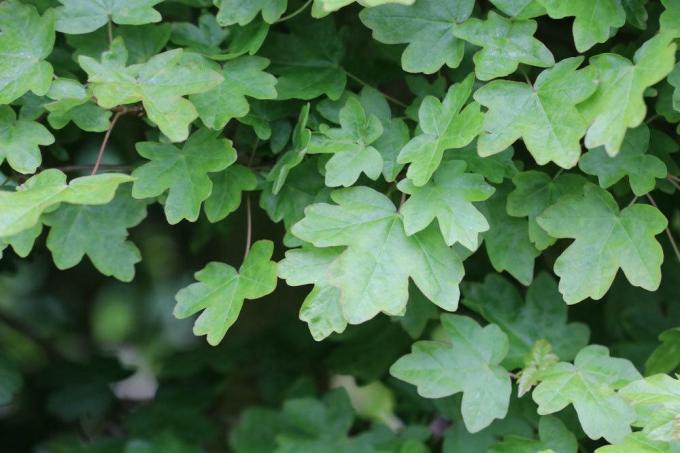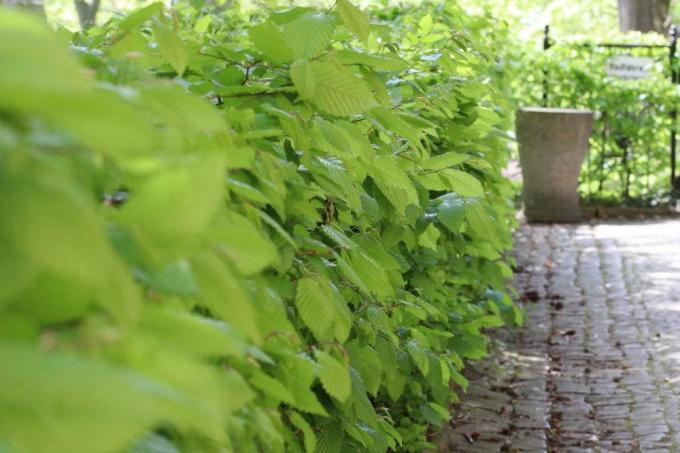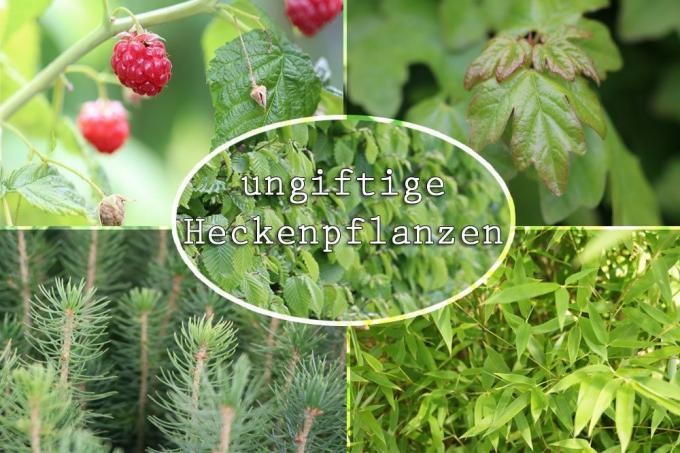
table of contents
- Non-toxic hedge plants
- Alpine currant
- Field maple
- Norway spruce
- Hornbeam
- raspberry
- Canadian hemlock
- Muriel bamboo
- Purple willow
- Roses
- Hibiscus
Hedges can be made from a wide variety of plants, but many of them are poisonous! However, there are also a large number of plants that are not poisonous and pose no danger to humans or animals. In the following article ten non-toxic hedges are presented.
Non-toxic hedge plants
Hedge plants are planted both in public areas, such as parks or kindergartens, but also in the home garden. A variety of different plants can be used for this purpose, from berry bushes to conifers. However, these include many poisonous plants, which are a potential danger, especially for children and animals. However, there are also a number of hedge plants that are non-toxic and can therefore be easily grown in the home garden. The following hedge plants are not poisonous.
Alpine currant
The Alpine currant is not poisonous and, unlike other Ribes species, does not have any spines or thorns. The deciduous shrub is densely branched and reaches a height of up to 250 centimeters. The alpine currant flowers from April to May and bears spherical, scarlet berries in August. Although these are non-toxic and edible for humans, they taste rather bland. However, many birds enjoy the berries, which is why the alpine currant is also considered a bird nutritional wood.
- botanical name: Ribes alpinum
- Synonyms: mountain currant
- Genus: Currants (Ribes)
- Family: Gooseberry Family (Grossulariaceae)
- Location: undemanding, sun or shade
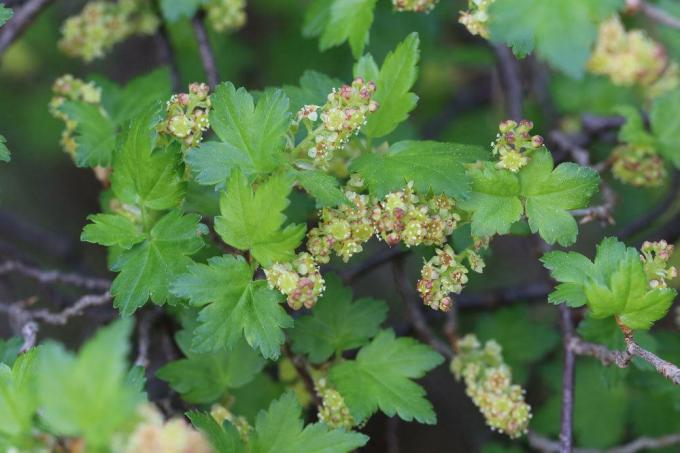
Note: The alpine currant is very compatible with salt and car exhaust. It is therefore ideally suited as a hedge plant to shield the home plot from street noise.
Field maple
The field maple is not particularly demanding, but should be cut regularly. The native wood grows up to 45 centimeters per year and is therefore ideal for high hedges. When properly cared for, the field maple forms yellow flowers in May and turns its foliage a splendid yellow and / or orange. While many maple species contain the harmful substance hypoglycine A, the field maple is completely non-toxic and therefore harmless to humans.
- Botanical name: Acer campestre
- Synonym: Maßholder
- Genus: Maples (Acer)
- Family: Soap Tree Family (Sapindaceae)
- Location: nutrient-rich, moist to alternately dry, warm and calcareous
Norway spruce
The common one Spruce is one of the few non-toxic conifers that can also be grown as a hedge. Because it convinces with its opacity and thus offers effective privacy protection. With hedges like these, however, it is important to note that the Norway spruce should not be cut too narrowly. A minimum width of around 80 centimeters and a minimum height of 150 centimeters are recommended.
- botanical name: Picea abies
- Synonyms: common spruce, red spruce, red spruce
- Genus: Spruce (Picea)
- Family: Pine family (Pinaceae)
- Location: possible anywhere, not too hot and too dry
- Cut: annually, narrow hedges twice a year
Hornbeam
The hornbeam is considered one of the best hedge plants and is also non-toxic. It grows free-standing as a medium-sized tree or shrub and is found mainly in Europe and Western Asia. It can happen that the tree reaches heights of growth of up to 25 meters or more. The hornbeam adorns its location in summer with healthy, green foliage. It partly retains its leaves over the winter, but they turn yellow-brown in color in the cold season.
- Botanical name: Carpinus betulus
- Synonyms: hornbeam, hornbeam, hornbeam
- Genus: Hornbeam (Carpinus)
- Family: Birch family (Betulaceae)
- Location: undemanding, sun or shade
raspberry
Berry bushes are also suitable as hedge plants, such as the raspberry, proves. It blooms and fruit in the 2nd Year and bears a variety of tasty fruits. Depending on the variety, these can be harvested from July to late autumn. Because summer raspberries are harvested from July and September, whereas the fruits of autumn raspberries are only ripe between August and October. The evergreen pseudo shrub reaches a height of 0.6 to 2.0 meters, but likes to lose its shape. It is therefore advisable to cut them regularly.
- botanical name: Rubus idaeus
- Synonyms: Hintperi, mollberry
- Genus: Rubus
- Family: Rosaceae
- Location: partially shaded to sunny, loose and humus-rich soil

Note: Who Raspberries If you want to grow as a hedge, you need about two to three raspberry bushes per meter.
Canadian hemlock
The evergreen Canadian hemlock is hardy in local regions, which is why it is perfect as a privacy hedge. It also poses no danger to children or animals, because the Canadian hemlock is not poisonous. While it bears its green needles all year round, it forms inconspicuous flowers in May and bears stalked, egg-shaped cones. The latter reach a length of about 1.5-2.5 centimeters and a diameter of 1-1.5 centimeters.
- botanical name: Tsuga canadensis
- Synonyms: Canadian hemlock
- Genus: Hemlocks (Tsuga)
- Family: Pine family (Pinaceae)
- Location: sunny to partially shaded, fresh to moist soil

Note: The Canadian hemlock does not bloom until it is 20 to 40 years old.
Muriel bamboo
The Muriel bamboo is also one of the non-toxic hedge plants and therefore does not pose a threat to children or animals. It forms a large number of upright stalks that can reach a height of one to five meters. The evergreen hedge plant is hardy and can easily cope with temperatures as low as -20 ° C.
- botanical name: Fargesia murielae
- Genus: Fargesia
- Family: Sweet grasses (Poaceae)
- Location: partially shaded or sunny

Note: The Muriel bamboo is well opaque after a few years, which is why only a few copies are needed.
Purple willow
The purple willow is a large, upright shrub that can reach a height of up to six meters. The flowering time of the purple willow is from March to April, in which it forms female and male "catkins". By the way, the name is hinted at the latter, because the male pussy willow is reddish in color, whereas the leaves of the purple willow are dull green.
- botanical name: Salix purpurea
- Genus: Willows (Salix)
- Family: Willow family (Salicaceae)
- Location: sunny or partially shaded

Note: The purple willow attracts numerous insects, so it is a welcome source of food for honey and wild bees, among others.
Roses
Hedge plants often act as privacy screens, but they can also be extremely decorative! Because roses are excellent hedge plants, which not only grow densely, but also impress with their beautiful flowers. If the roses are grown as hedge plants, they should be at least 180 centimeters high. It is therefore advisable to plant larger roses, such as wild, shrub and / or park roses.
- botanical name: pink
- Synonyms: Queen of Flowers
- Genus: roses
- Family: Rosaceae
- Location: sunny and airy, nutrient-rich and humus soil

Note: Roses are non-toxic, but the plants develop spines. Since there is a risk of injury to children and animals, caution is always required here!
Hibiscus
The hibiscus is a medium-strong growing wood that is ideal both individually and in groups. It grows upright and reaches a height of one to four meters. The deciduous shrub forms numerous flowers from July to September, which can have a wide variety of colors. There are also some varieties that are multi-colored and have a different colored flower center, for example.
- botanical name: Hibiscus syriacus
- Synonyms: Garden hawk, festival flower, sweet rose, Syrian marshmallow
- Genus: Hibiscus (Hibiscus)
- Family: Mallow family (Malvaceae)
- Location: full-bodied, nutritious and well-drained soil
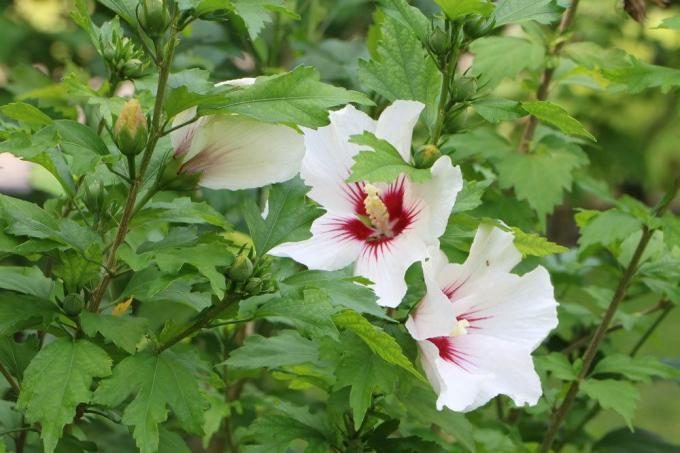
Not sure if your hedge plant is poisonous? A list of 10 poisonous hedge plants can be found here.

